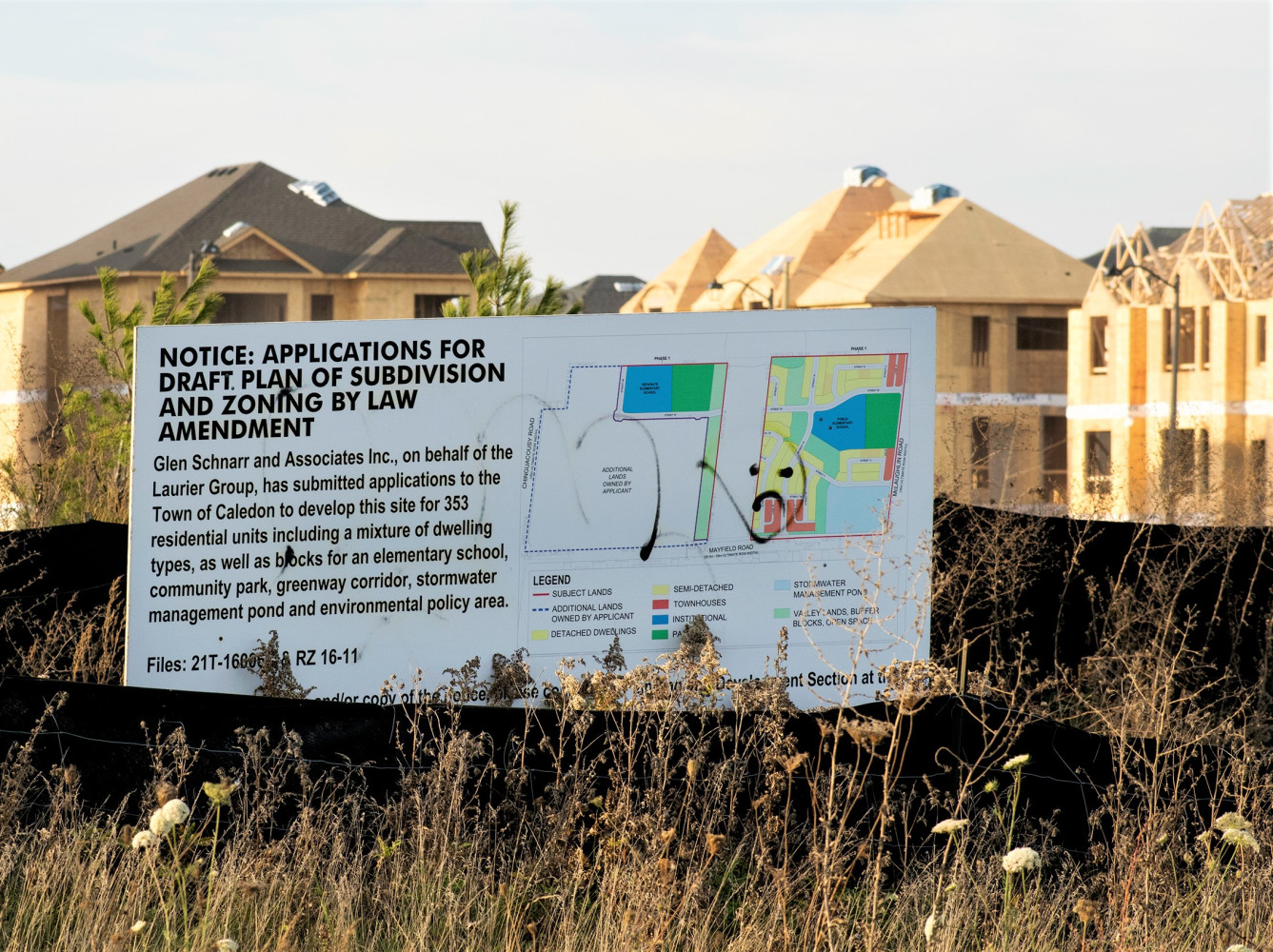
Development on steroids: Brampton’s growth plans exploded by ill-conceived Bill 23
Now in limbo while waiting for provincial direction, Brampton’s Official Plan will have to undergo “fundamental” changes impacting the city including population targets, employment and the construction of new homes and infrastructure after the passing of the PC government’s controversial Bill 23.
Dubbed “the trainwreck Bill” within Brampton’s council chambers, Bill 23, the More Homes Built Faster Act, has been decried by Council, residents, local advocates and environmental groups. Stakeholders have argued that without sweeping amendments it will make Peel’s affordable housing crisis even worse, put residents and businesses in existing floodplains at greater risk and blow apart current emissions reductions targets.
The Bill, passed by the PCs without any consultation between municipalities, sets a target of 113,000 new homes in Brampton by 2031, which equates to approximately 400,000 new residents, growth the city simply can not accommodate in such a short period. This housing target in less than ten years represents an annual average of 14,125 new households per year, equating to an annual increase in total housing growth three times the city’s historical average over the past 20 years.
Council members were told during a January 25 meeting that staff are currently working to submit a Municipal Housing Pledge requested by the province for a March, 2023 deadline. Part of the staff's analysis will be looking at how the cash-strapped city can meet expectations under the unexpected provincial legislation, which has caught municipalities across Ontario off guard.
“Some of you may recall in our previous presentations to Council on Bill 23, staff have some reservations about that impressive target,” Steve Ganesh, commissioner for the City’s Planning Building and Development department, told Council. “It represents issuing housing about three times the rate we currently do per year in the City, and that’s some of our historic highs. Staff are looking at that target and we’re going to be bringing back a report to Council in February on thoughts on how Council could approach that pledge.”
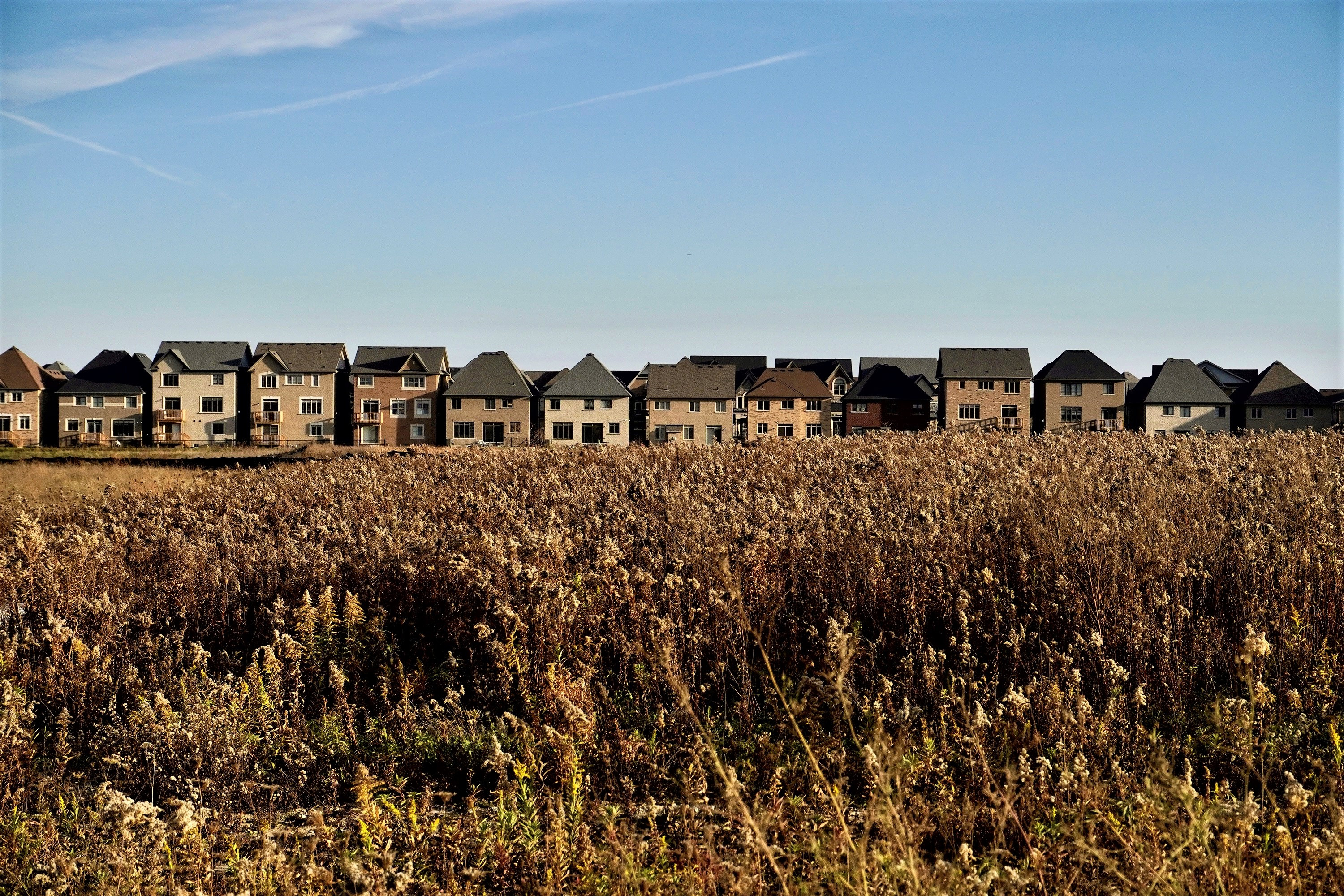
Subdivision sprawl, with more large homes, is the preferred model of developers who pushed for Bill 23.
(Alexis Wright/The Pointer)
Councillor Michael Palleschi, who called the Bill a “trainwreck”, questioned staff on the feasibility of the targets, stating he’s spoken with building industry stakeholders in the city who have told him they couldn’t meet that target if they wanted to.
“That was based off our historic highs? Like, 15 years ago when we were pumping out permits, fastest growing city in Canada and we still didn’t even come close to that number?” Palleschi, who is the City’s planning chair, said to staff.
Councillor Martin Medeiros, who was planning chair the previous term of council, agreed with Palleschi, requesting staff to include the exact number of units currently approved with a building permit, which had recently sat at over 9,000. A report is expected in early February with an update to those numbers.
“Even if we were sort of put all these numbers… even with what’s outstanding it’s almost a pie in the sky, but that’s what the province wants,” Medeiros said.
Brampton’s new Official Plan was supposed to be scheduled for adoption early in 2023 after beginning development in 2019, following the historic 2040 Vision Master Plan adopted in 2018, after a Vancouver-based consultant was hired under former mayor Linda Jeffrey to piece together a progressive growth strategy for the city. The plan, focussed on much more dense, vertical complete communities, was shaped by thousands of Brampton residents and other stakeholders who took part in a series of public consultations across the city to create a more urban future for a bedroom community whose planning has fallen behind its booming neighours.
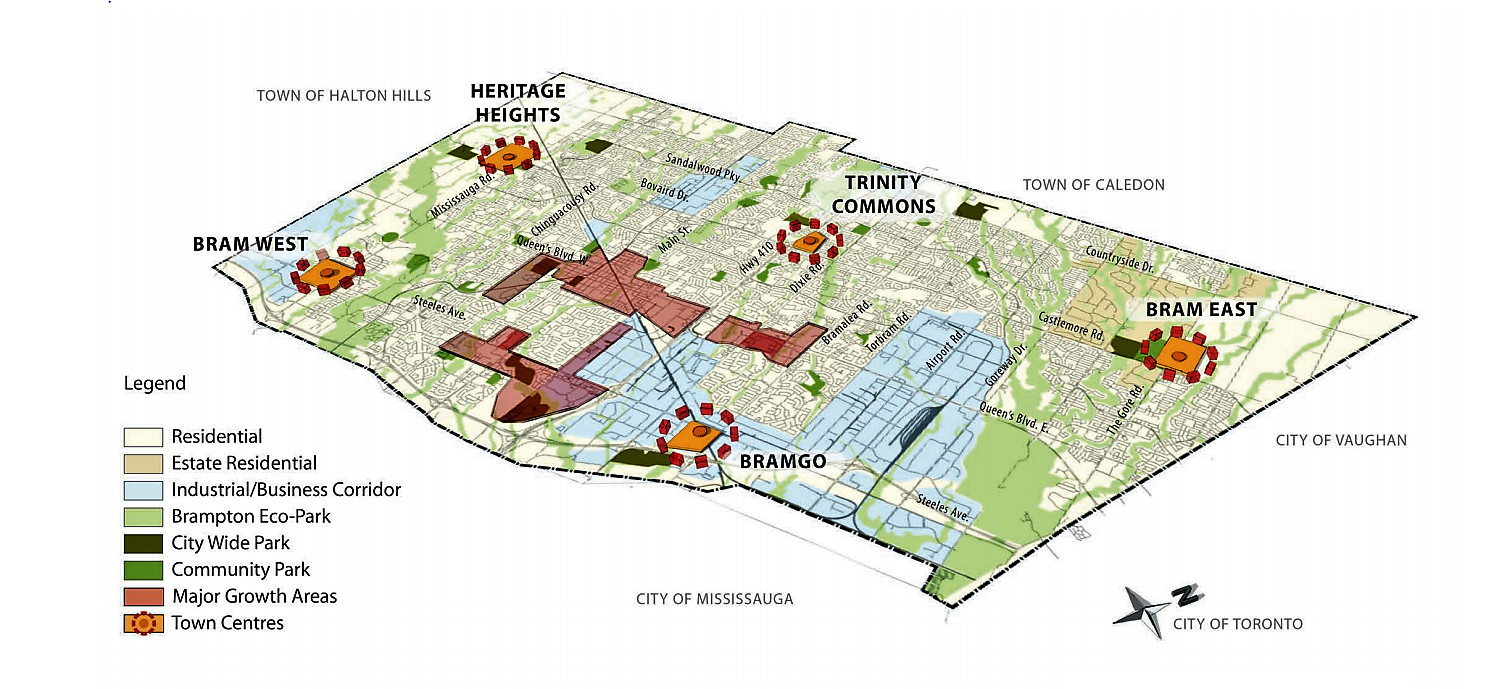
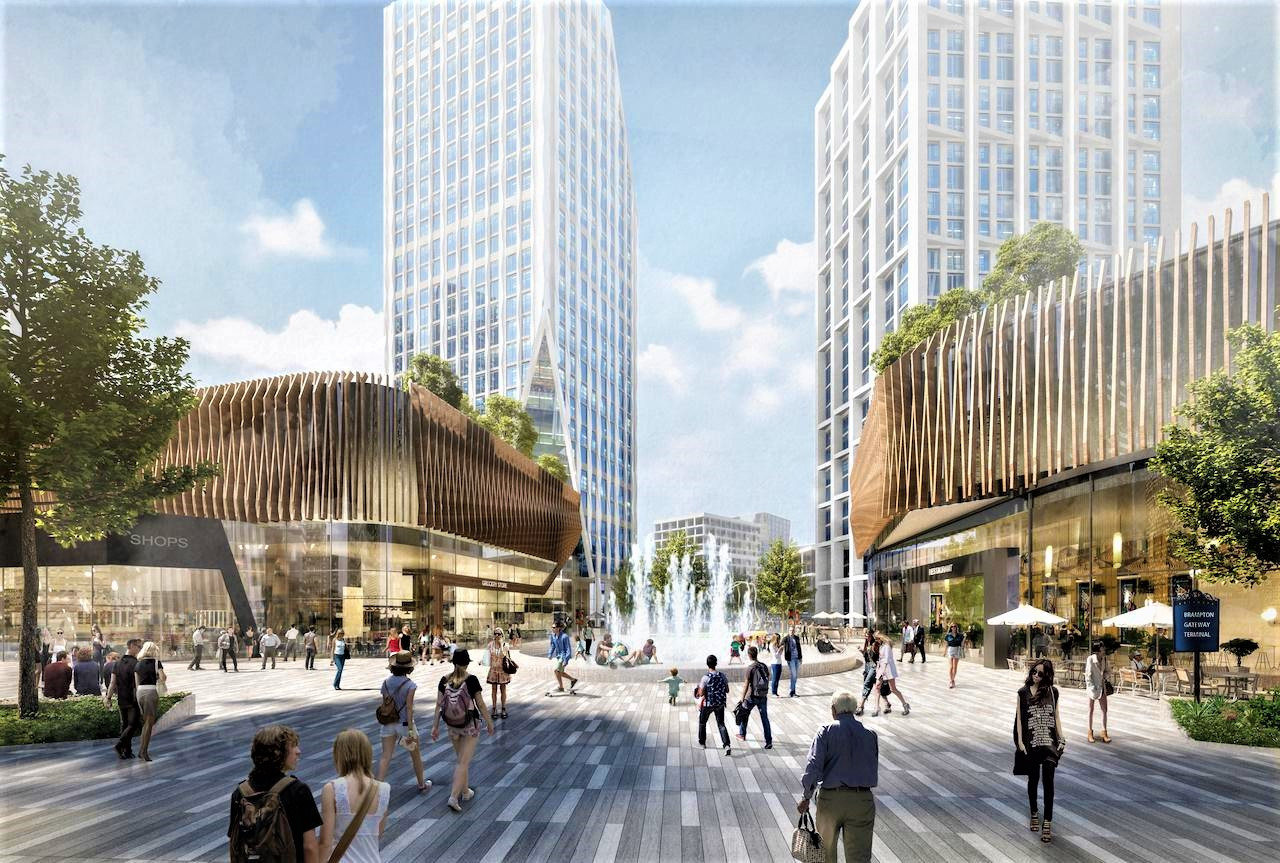
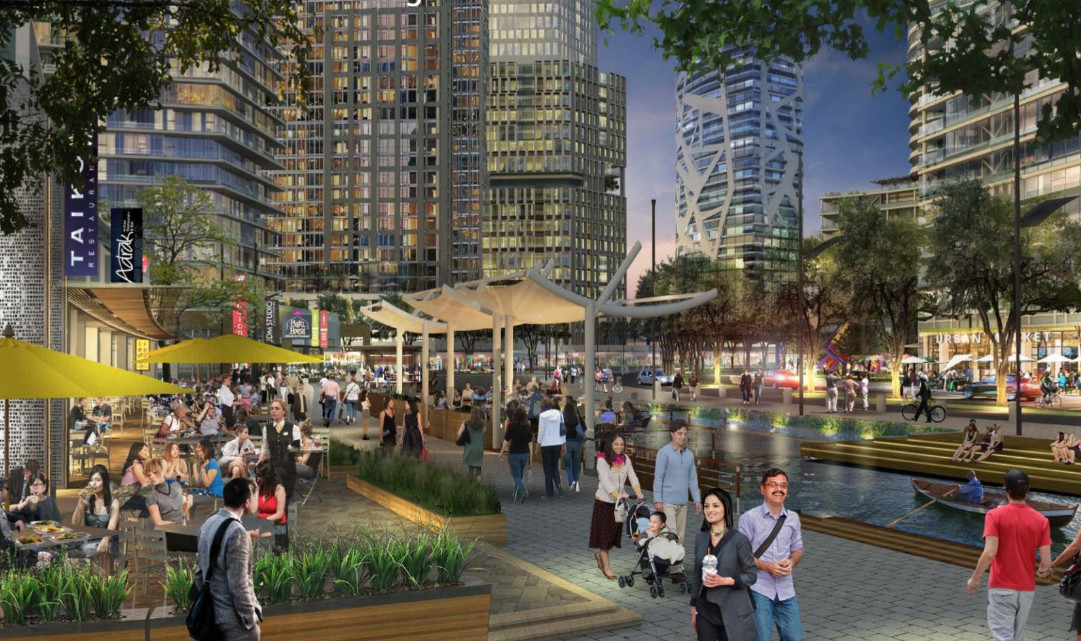
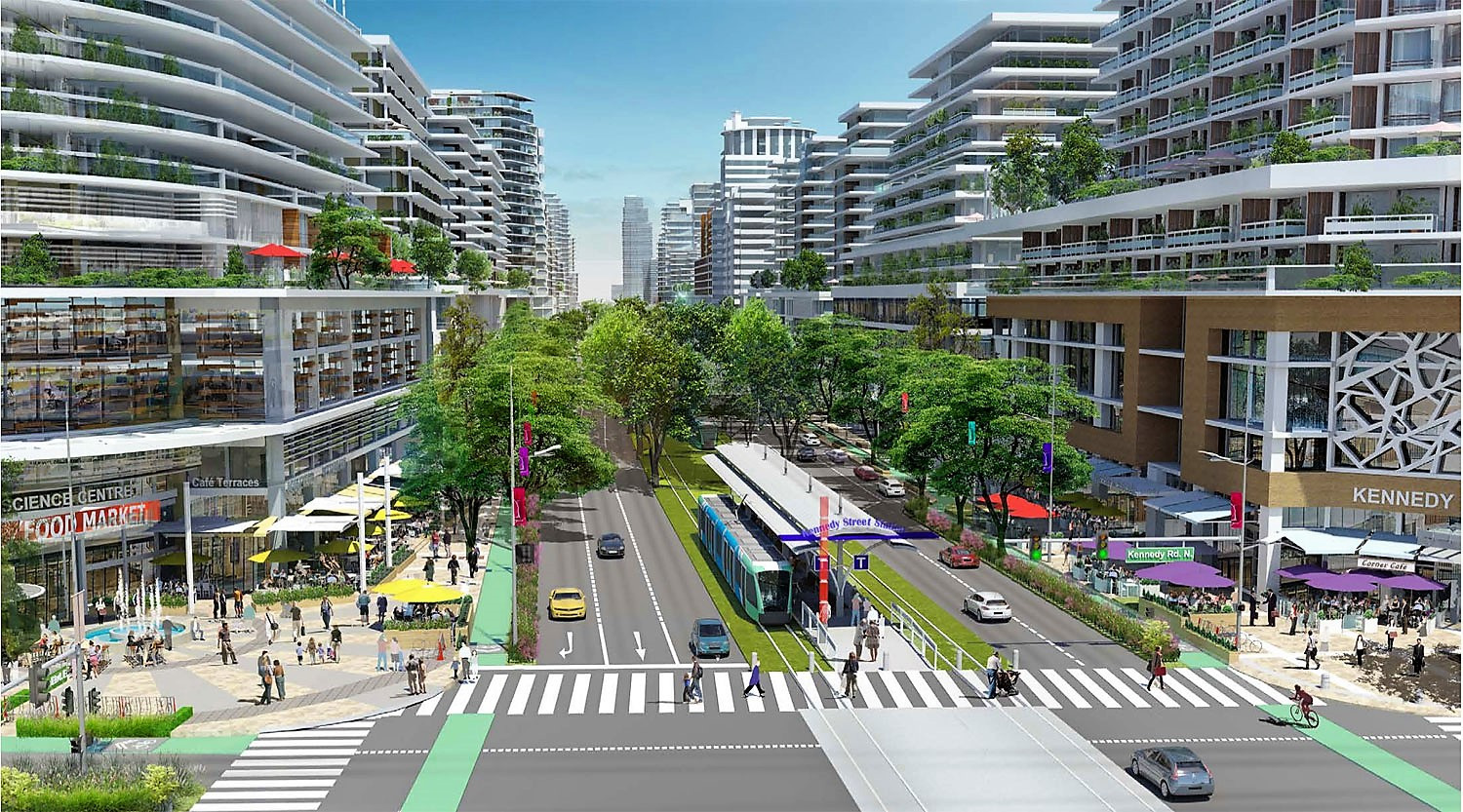
The 2040 Vision was adopted as Brampton's Master Growth Plan in 2018, and set out to create dense, walkable communities supported by transit throughout the city. From top; The 2040 Vision map of Brampton; the Shoppers World area; Bramalea; and Kennedy Road leading into downtown. Now, Bill 23 has left doubts about whether the city can grow the way it wants.
(Renderings City of Brampton)
On October 25, all those ideas were upended when the PC government pushed through Bill 23 which proposes significant changes to the provincial planning framework and land use approvals system. Instead of mandating the type of dense, complete communities the province had been working toward through its own groundbreaking Places to Grow Act, passed in 2005 to replace sprawl growth with compact urban design, Bill 23 marks a return to the way development was approached when the 905’s endless subdivisions were constructed decades earlier.
The pace of construction mandated under Bill 23 has left planners and other officials questioning how municipalities, and Queen’s Park will pay for all the required infrastructure and services to support the explosive population growth that would come with the legislation’s hyper-ambitious goal of building 1.5 million new homes by 2031. This amount of growth was originally intended to be spread out over the next three decades to 2051—it is now expected in just eight years. The target is even more difficult due to Bill 23’s shifting of growth-related funding away from developers who traditionally paid building fees to City Hall that covered costs for infrastructure to service their projects and future residents who purchased units from builders. Many of these costs, known as a Development Charge (DC), have been removed from the responsibility of builders, onto the backs of property taxpayers, under the Bill. To accommodate the timeline, its lofty targets and the revenue shift, staff told Council there are fundamental elements in Brampton’s Official Plan (OP), which guides growth, that need to be further analyzed.
According to City of Brampton staff, a number of fundamental and administrative elements of Brampton’s OP remain in question as they wait for direction from the PC government.
Other municipalities are way ahead of Brampton in assessing the impacts of Bill 23.
Mississauga staff reported the City “stands to lose almost $1 billion in revenue (over 10 years) that we use to pay for new parks and infrastructure like roads, trails, community centres, fire stations, libraries and more… which results in savings for developers but doesn’t guarantee that homes will be built or be affordable.”
Region of Peel staff project $2 billion in lost revenue. Residents could pay as much as 10 percent more for property taxes with large increases on their utility bills, Mississauga and Region of Peel staff have warned.
This past week, Durham Region staff reported Bill 23 will cost their government $281 million over five years, revenue that taxpayers will be forced to make up.
The Association of Municipalities of Ontario estimates the legislation will cost cities and towns at least $5.1 billion by 2031, most of it pushed onto tax payers.
Beyond the financial impacts, which have been more closely analyzed since Bill 23 was forced through late last year by the PCs, the effect on growth planning and city building has not been as closely scrutinized.
After three decades of sprawl, driven by subdivision developers, Brampton hoped to turn a corner and pursue the type of growth places like Mississauga, Vaughan and Markham have shifted toward—transit oriented, walkable communities with everything from government services, dining and entertainment as well as other consumer offerings located in more dense urban neighbourhoods.
Bill 23 has thrown Brampton’s recent planning into a tailspin.
Staff noted that in the absence of clear direction from Ford and his government about how municipalities will be supported in order to conform with the legislation, there is a significant risk of not meeting the early 2023 timeline for Brampton to finalize its OP as previously communicated to Council in August.
“In absence of further direction from the province on implementation of Bill 23, a number of fundamental and administrative elements of Brampton Plan remain in question. As such, Brampton Plan will need updating to consider changes set out in Bill 23, to ensure the City is strategically prepared to support the magnitude of growth it will experience in the coming decades,” staff told Council in a report presented to the City’s Planning & Development Committee meeting on January 23.
The PC government's housing legislation, Bill 23, has forced Brampton planning staff to reconsider the City's growth strategy. Once further details from the Province are provided, staff will report back to Council about how Brampton should pursue its own growth plan.
(City of Brampton)
During the January 23 meeting, Council unanimously passed a recommendation requesting that the PC government provide an update as to when the remaining elements of Bill 23 will come into effect to allow the City to plan for “the timely and efficient adoption of Brampton Plan.”
The motion also requested staff to return with an update on timelines for the Brampton Plan once further information from the province is received; and that Council direct staff to bring forward housekeeping and other amendments to Brampton’s 2006 Official Plan in light of impacts to the initiatives under the new Brampton Plan timelines, including policy updates to guide development and growth in and around Major Transit Station Areas and more.
One of the concerns Ford has not addressed is how infrastructure for millions of residents will be provided under his legislated growth. Building 1.5 million new homes in eight years will require tens of billions of dollars to construct required hospitals, schools, GO transportation links, roads and many other hard and soft services. Ford has failed to provide any budget plans to ensure Queen’s Park will fund the very growth he is forcing onto the province.
Some of the impacts Brampton staff noted include effectively planning for both hard and soft infrastructure – ensuring the adequate provision of schools, parks, hospitals to serve the population increase; consideration of new transit projects, and expediting investment and implementation of ongoing transit projects; protection of employment lands, to ensure Brampton is economically competitive and hundreds of thousands of new residents have local jobs; all while ensuring the hyper-growth occurs sustainably and does not threaten environmental systems.
This is in addition to several administrative elements, which currently can’t move forward. These include new planning instruments to meet conformity requirements; with the Minister of Municipal Affairs now serving as the main approval authority for the plan – not the Region of Peel, which for decades had overseen municipal planning.
In the meantime, the recently approved Region of Peel Official Plan (RPOP) will be an in-force Official Plan for Brampton until the City finalizes its own OP update.
City staff said they will need “sufficient time” to make sure the Region’s plan supports how the City wants to grow while eliminating redundancies between the two levels as the entire growth process is rethought under Bill 23.
Critics, including Mississauga Mayor Bonnie Crombie, have said Bill 23, along with other supporting legislation forced by Ford and his PCs which erode municipal planning control, is all part of an effort being driven by powerful developers (media reports have highlighted their donations to Ford).
Staff told elected officials they will address impacts from the removal of planning authority from the Region, and what it will mean to answer directly to the PC government, which now, effectively, has taken over planning authority for Brampton.
Email: [email protected]
Twitter: @JessicaRDurling
COVID-19 is impacting all Canadians. At a time when vital public information is needed by everyone, The Pointer has taken down our paywall on all stories relating to the pandemic and those of public interest to ensure every resident of Brampton and Mississauga has access to the facts. For those who are able, we encourage you to consider a subscription. This will help us report on important public interest issues the community needs to know about now more than ever. You can register for a 30-day free trial HERE. Thereafter, The Pointer will charge $10 a month and you can cancel any time right on the website. Thank you
Submit a correction about this story


